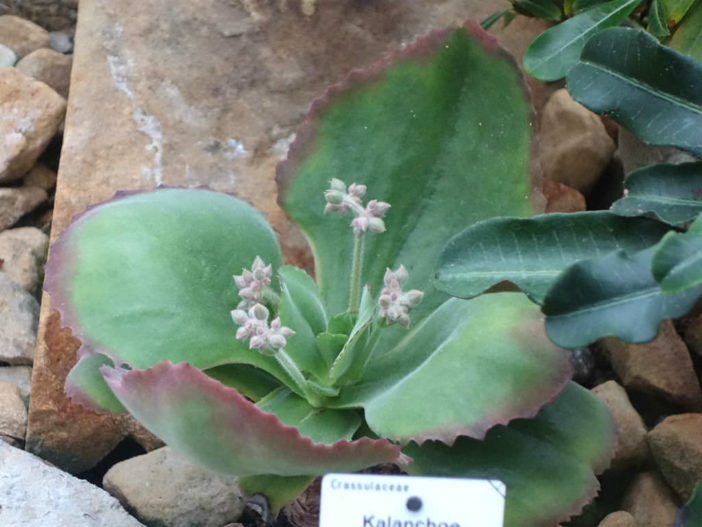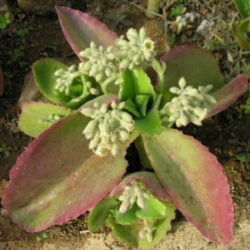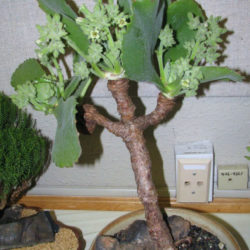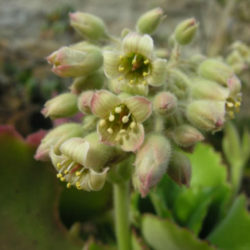Scientific Name
Kalanchoe tetraphylla H.Perrier
Scientific Classification
Family: Crassulaceae
Subfamily: Sedoideae
Tribe: Kalanchoeae
Genus: Kalanchoe
Origin
Kalanchoe tetraphylla is native to Madagascar. It occurs in rocky places at elevations between 3,280 and 6,560 feet (1,000 and 2,000 m).
Description
Kalanchoe tetraphylla is a succulent plant with an upright, woody stem bearing a terminal rosette of short, broad, reddish or green leaves with serrated margins. The stem is usually short but can reach 5 feet (1.5 m) in height. Leaves are up to 6 inches (15 cm) long and nearly equal in width, densely glandular-hairy when young, becoming smooth with age.
The bell-shaped flowers have green to reddish sepals and white-yellow to yellow-green petals streaked with purple, all clothed with white glandular hairs. They appear in dense clusters on hairy, up to 6 inches (15 cm) tall stalks from within the leaves, usually in fall.
This rare species is closely related to Kalanchoe synsepala, and they are the only known Kalanchoe species that typically do not have terminal inflorescences but rather lateral arising in the axils of the leaves.
Kalanchoe tetraphylla has been confused in the literature with Kalanchoe thyrsiflora.

Hardiness
USDA hardiness zones 9a to 11b: from 20 °F (−6.7 °C) to 50 °F (+10 °C).
How to Grow and Care
Kalanchoe care is minimal, but be cautious about light levels. Intense sunlight can burn the tips of the leaves. Place pots in partial sun to light shade areas when growing Kalanchoes.
The flowering varieties are highly rewarding for their colorful and long-lasting flowers. They prefer bright, sunny locations, especially in the growing season. Water moderately from fall to winter when the growth is most active. Reduce watering during the hottest summer months when the plants are mostly dormant and winter when the growth slows significantly. Let the soil surface dry out between waterings. Watch the fleshy leaves for signs of water distress. An ordinary potting soil mix is fine. Feed bi-weekly during the growing season with a liquid fertilizer, or use slow-release pellets.
These small plants require repotting every few years. When repotting, take additional care in handling as the leaves are somewhat brittle and can snap easily. Clay pots work exceptionally well for planting Kalanchoes. Ensure pots can drain well and saucers can empty easily.
Learn more at How to Grow and Care for Kalanchoe.
Links
- Back to genus Kalanchoe
- Succupedia: Browse succulents by Scientific Name, Common Name, Genus, Family, USDA Hardiness Zone, Origin, or cacti by Genus
Photo Gallery
Click on a photo to see a larger version.


